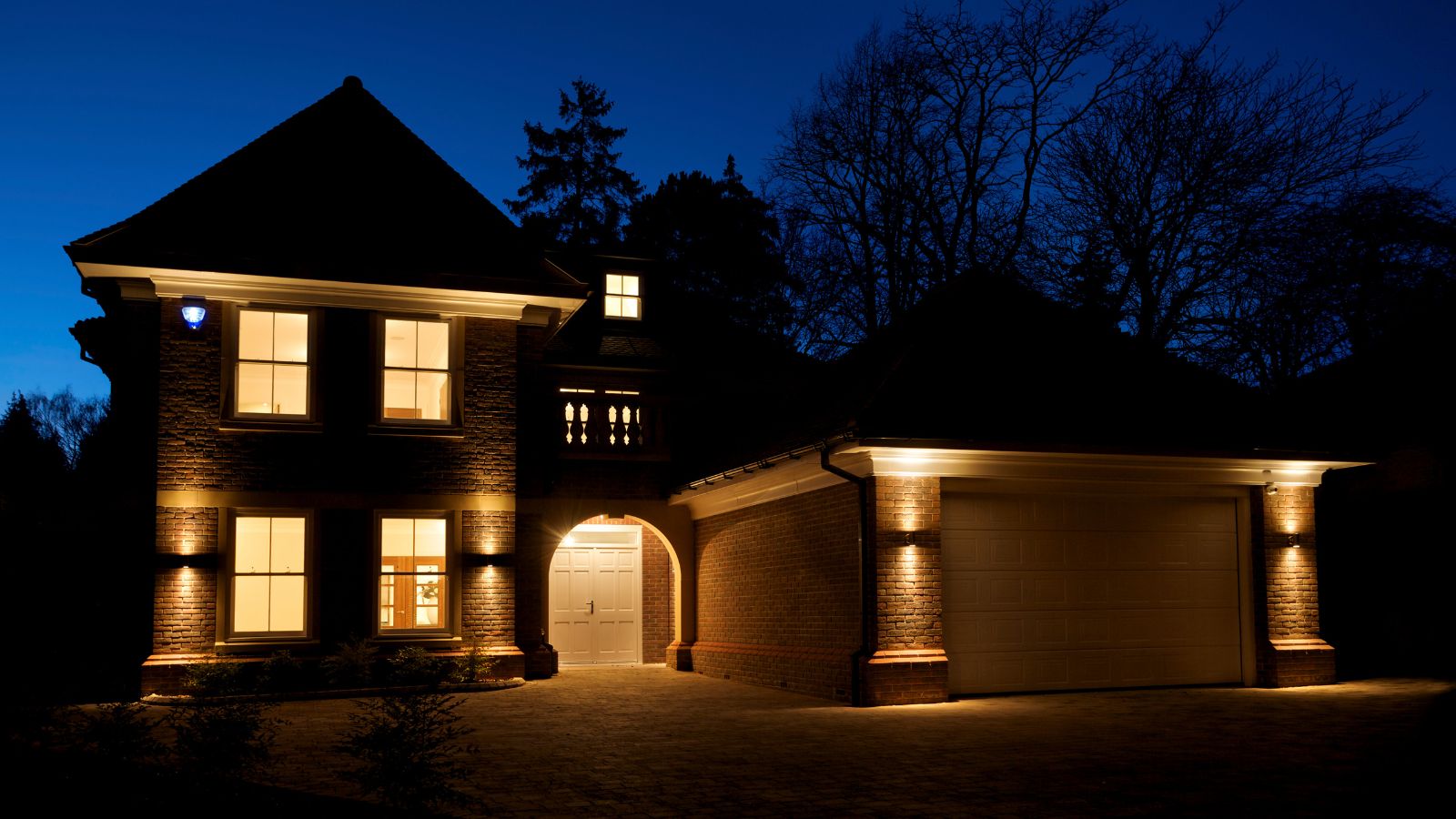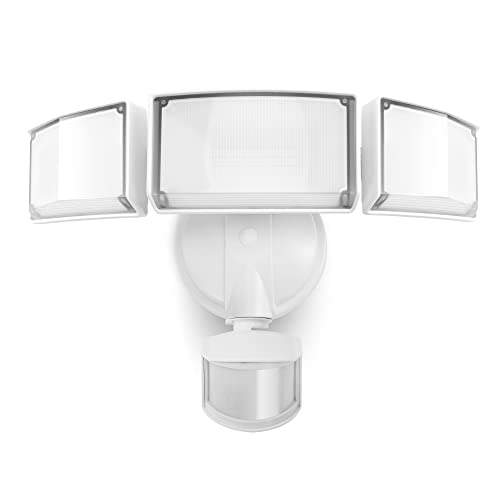The best places for security lights – crucial advice from a former FBI agent
Security and law enforcement experts reveal the smartest spots to put security lights


One of the best ways to secure your home is with a good set of garden security lights. They remove dark corners where intruders can hide and lower the chance of burglary.
However, it's not always obvious how you should set them up, or how many you need. And you might need to prioritize where and how you place your lights for maximum effect.
To clear up any confusion, I spoke to home security experts - including a retired FBI special agent - about the best places for your security lights.
1. Place them high up

The golden rule for security lights is to install them as high up as possible. Former FBI special agent and security expert Kim Wright says 'The best height to mount security lights is between six to ten feet above the ground.' Security expert Kirk MacDowell goes even further, and says 'Security lights should generally be installed between 9 to 12 feet high.'
There are a couple of reasons for this. Home security product expert Jonah Serie told me that 'Failing to follow this simple step may lead to a burglar simply removing bulbs to keep the area dark. Making it difficult to unscrew the bulbs will make the property less inviting to potential robbers.'
On top of that, there is a simple practical reason. The higher the bulb, the better the light coverage. You'll be able to illuminate a larger area with fewer lights, saving you a little money.

Kim Wright is the Director of Corporate Security at ADT. She was an FBI Special Agent for 22 years.

Kirk is a Home Security expert at Batten Safe and is a 40-year veteran of the security industry. He is a highly regarded figure with experience working as an executive and board member of various security associations. Additionally, he is a retired law enforcement officer– an experience that gives him a unique consumer perspective.

Jonah is the Senior Vice President of Field Operations at Brinks Home, a home security company. Before this, he was Vice President of Operations and an Area General Manager at ADT Security Service.
2. Point away from your windows
Former FBI agent Kim Wright gave me some great tips about security light sensors. It's not just the light that matters, but the sensor, because this is what triggers the light.
Design expertise in your inbox – from inspiring decorating ideas and beautiful celebrity homes to practical gardening advice and shopping round-ups.
Most sensors have pretty wide detection ranges, usually above 150°. This means that it often doesn't matter where you aim a sensor, because it will usually pick up motion.
However, Kim says it's vital to point the sensor away from your windows. 'To prevent false alarms, avoid directing the sensor at windows or glass doors, as any movement detected in these areas might accidentally trigger the sensor.' It can be alarming to get this wrong; your lights will trigger all the time, making it seem like there are lots of people going in and out of your yard when you're the one setting them off.
Instead, Kim says 'You should aim your security light sensor in high-traffic areas and any easily accessible locations around your home. Position the sensor where an intruder would potentially walk through its field of view.'
The sensor should be placed so it triggers when people walk through its beam. Kirk MacDowell warns that motion sensors aren't always great at detecting motion head-on, and are better at detecting motion across their beam. If your security light has a more limited motion detection range, it may be smarter to position the sensor where people will walk across rather than head-on.
In some cases, it's also better to think a little laterally and point the sensor off your paths. If, for example, you want to have a spotlight on a driveway, potential burglars might spot this and stick to the side of the front yard. In this case, it makes sense to point the sensor - not the light - at the corners of the yard rather than the spot you want to illuminate.
3. Use recessed lights in porches

Good lighting on a porch or entryway is essential because they are the main access points to your home. Thankfully, you don't need anything too complicated.
Kirk MacDowell says 'A recessed light above the porch is ideal. It provides sufficient lighting without being too harsh, making it an effective yet unobtrusive security measure.' Not only is it stylish, providing light without you needing an ugly, functional security light, but it's secure, too. By its nature, a recessed porch light will sit at least 9 feet above ground, so it's hard to tamper with, and because it's recessed, it can't be knocked off or broken.
However, a wall-mounted porch light will also do the job. The key is to keep your lights on timers. Jonah Serie says that 'Lights on timers are great at ensuring a home and its surrounding property always have ample illumination, even when darkness sets in. It is best to switch the light’s timing frequently, so a pattern is not recognized.' This will always give the illusion that someone's home, deterring potential burglars.
3. Use floodlights above a driveway

The best option for driveways and garages is a motion-detection floodlight. There are a couple of reasons for this.
The first, reason, unrelated to security, is that a floodlight is just plain useful. If you come home in the dark, a motion-detecting floodlight will make your driveway much easier to navigate. If you need to take groceries out of the car, a floodlight will make it much easier to see what you're doing.
On top of utility, floodlights are great for security. Jonah Serie says, 'Floodlights provide plenty of lighting, making it harder for a thief to hide without being detected. In addition, motion detection lights brighten areas quickly. If someone makes a sudden movement, these lights will trigger, illuminating the area where a perpetrator is located. This will cause the person to leave the area rather than putting themselves at risk of exposure.'
You don't need to do anything fancy for this. Kirk MacDowell says that all you need to do is 'Install lights above the garage that shine down onto the driveway.' This keeps the lights out of reach for tampering and ensures the whole area is brightly lit.
However, it also pays off to pay attention to dark corners between a porch and a garage. Former FBI agent Kim says 'You should also consider blind spots. These areas could potentially serve as access points for intruders to enter homes unnoticed, making it important to equip these blind spots with security lights.'
4. Along a fence
There are a couple of options with fences. The first is fairly obvious. You can place lights along the top of the fence panels or posts, shining down onto the fence. This provides gentle illumination that looks great, and it should keep your home secure. However, depending the height of your fence and garden layout, it would be pretty easy to tamper with these lights.
That's also true for another option, uplighting the fences with spotlights. This looks fantastic, and it's easily the best-looking option. However, these lights need to be installed on the ground, so they're easy for intruders to kick over. They also only light a small area, so it's easy for people to skirt around them.
The best method for security is to light the fence from a distance. Kirk MacDowell says to 'Place lights off the fence line, facing towards your home. Mounting lights on poles or in trees shining back at the fence ensures the lights are difficult to reach and tamper with.' It doesn't make for the prettiest landscape lighting, but it's the most secure.
6. Place them so they overlap

However you place your lights, you need to make sure that each light overlaps with another. Dark corners of the yard are particularly dark compared to brightly lit spots illuminated by security cameras.
Kirk MacDowell says to 'Aim for consistent coverage, ensuring there are no dark spots. Each light should cover the area where the previous one ends, providing seamless illumination.'
FAQs
How many security lights do I need?
There's no hard and fast rule about how many lights you need. You need as many lights as it takes to provide light coverage over the whole of your lot.
It's not just your exterior lights which can help to keep your home secure. One of the best home security tips is to consider your interior lights. Jonah Serie says 'Inside of the home, it’s generally a good idea to use any type of lighting that will make a thief believe you’re home.'
Setting lights on a timer is a great way to give the illusion that you're home, but Jonah advises, if possible, you should set your lights to go off at random times each day - 6:03 rather than 6:00 on the dot. Just as with exterior lighting, this looks more natural from the outside than lights switching on and off at predictable times.

As a gardens and lifestyle contributor, Alex makes sure readers find the right information to help them make the best purchase. Alex got his start in reviewing at the iconic Good Housekeeping Institute, testing a wide range of household products and appliances. He then moved to BBC Gardeners’ World Magazine, assessing gardening tools, machinery, and wildlife products.





![Claoner Solar Lights Outdoor [𝟔 𝐏𝐚𝐜𝐤/126 Led], Wireless Motion Sensor Lights, Ip65 Waterproof Security Lights 3 Modes, 270° Lighting Angle, Ultra-Bright Wall Lights for Deck Patio Fence Garage](https://cdn.mos.cms.futurecdn.net/siaiE66pgVhbCVQwxkvJcW.jpg)